Duration of Open Bite Treatment
The issue of open bite is gaining increasing importance in the field of orthodontics, as it is one of the most impactful malocclusions affecting both the functional and aesthetic aspects of the mouth, teeth, and facial appearance.
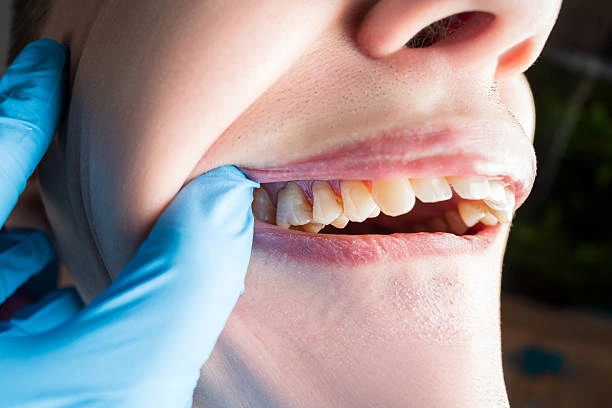
Duration of Open Bite Treatment
In the world of orthodontic treatment, the duration of open bite treatment stands out as a central question that concerns both families and patients alike. The treatment duration varies greatly depending on the cause of the condition, the patient’s age, the chosen treatment type, and the level of patient cooperation with the treatment plan.
The treatment period may range from a few months in children’s cases to several years for adults or complex, advanced cases.
Therefore, obtaining a precise medical consultation is essential to build a clear treatment plan and help patients understand each step realistically — ensuring that the open bite correction journey does not become a long, difficult experience without results or clear expectations.
In this article, we will thoroughly discuss the duration of open bite treatment, the treatment of open bite in children, the impact of open bite on the jaw, and the topic of relapse or symptom persistence after orthodontics.
Treatment of Open Bite in Children
The journey of open bite treatment usually begins at an early age when the dentist or family notices that the upper and lower front teeth do not meet when the mouth is closed, leaving an abnormal gap between the front incisors.
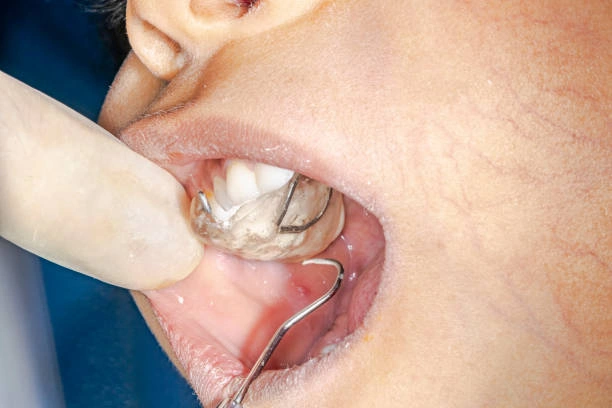
Treatment of Open Bite in Children
The importance of the duration of open bite treatment in children
lies in the possibility of shortening the treatment time and achieving excellent results in a shorter period compared to chronic cases in adults.
Often, the cause of open bite in children is behavioral — such as thumb sucking or prolonged pacifier use — or due to breathing problems that make the child accustomed to keeping the mouth open during sleep or wakefulness. In such cases, orthodontists emphasize addressing the cause first, whether by stopping the habit or treating tonsil or nasal enlargement.
When the family and dentist successfully correct these behaviors or health conditions, the teeth may begin to return gradually to their normal position within 3–6 months. In cases requiring a special orthodontic appliance or devices placed inside the mouth, the treatment period may extend from six months to about a year and a half, depending on the severity of the open bite and the flexibility of the mouth’s response to the devices.
Experts stress the importance of monthly follow-ups, where orthodontic devices are adjusted and tooth and jaw growth are closely monitored. In some cases, continuous preventive treatment is needed until all baby teeth have been replaced by permanent ones. Using special retainers remains essential to stabilize the new bite and prevent relapse in the future.
In summary, the earlier the intervention in children, the shorter the duration of open bite treatment and the easier it becomes to maintain results. In contrast, delays lead to increasing complexity and a higher likelihood of needing later orthodontic and surgical treatment.
Effect of Open Bite on the Jaw
Chronic bite problems pose a real threat to the structure and function of the jaws, and their consequences often appear only after years — especially if the open bite is neglected or inadequately treated.
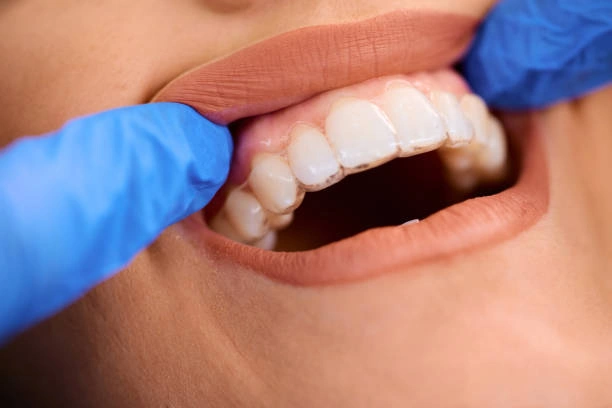
Effect of Open Bite on the Jaw
The importance of the duration of open bite treatment becomes clear in preventing facial muscle overgrowth or unbalanced bone development. Continued malocclusion changes the jaw’s functional dynamics and often leads to protrusion of the upper jaw or retraction of the lower jaw — altering facial appearance, the smile, and the patient’s self-confidence.
Functionally, the patient may struggle with normal chewing, which can result in malnutrition or indirect digestive issues. If the open bite persists into adulthood, surgical intervention may be required to reposition the jawbones before or after orthodontics. In such combined orthodontic–surgical cases, the duration of open bite treatment extends to several years.
Clinical studies confirm that neglecting or postponing open bite correction in childhood leads to worsening of the problem and makes future treatment more difficult.
It alters the temporomandibular joint structure and affects pronunciation and speech clarity.
Hence, early diagnosis and addressing the root causes are crucial to prevent the open bite’s effects from worsening and to avoid excessively long treatment periods that may exhaust the patient and family.
Open Bite After Orthodontic Treatment
Orthodontic treatment is an effective solution for open bite correction; however, some cases experience relapse or partial reopening of the bite after treatment completion.
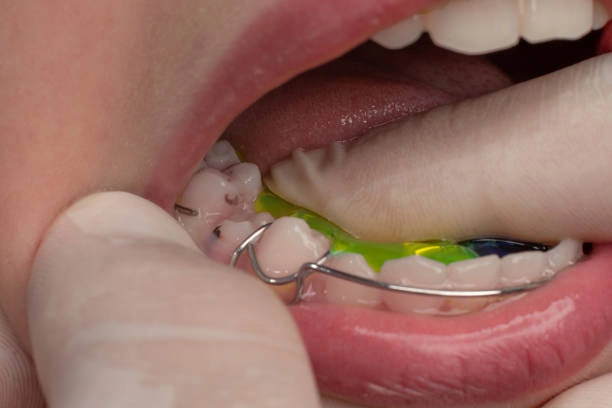
Open Bite After Orthodontic Treatment
The duration of open bite treatment is not only significant during the active orthodontic phase but also during the retention period that follows. Consistent use of retainers and regular follow-ups significantly reduce the risk of relapse or the reappearance of gaps between the front teeth.
Many patients neglect wearing retainers or revert to old habits, which can lead to partial loss of treatment success within months or years. Experts explain that long-term success is tied to the retention duration, which typically ranges from six months to two years after orthodontics, depending on the dentist’s recommendation.
In rare cases where the cause is structural or genetic rather than purely behavioral or functional, an additional orthodontic phase or even minor corrective surgery may be necessary to secure permanent results. In such instances, the duration of open bite treatment becomes more complex, encompassing both the active orthodontic phase and the long-term retention and monitoring period to ensure sustained improvement.
Thus, the treatment journey may progress through multiple stages, and patients must remain patient and disciplined to achieve stable final results. A long treatment duration does not necessarily indicate difficulty — rather, it reflects the need to allow gradual adaptation of the jaws and muscles to the new bite alignment.
Factors That Determine the Duration of Open Bite Treatment
Understanding the factors that determine the duration of open bite treatment helps patients anticipate the treatment course and prepare mentally and financially.
The most important factors include:
- Patient’s age: The younger the patient, the faster the response and the shorter the treatment.
- Cause of the problem: Is it behavioral (thumb sucking), muscular, skeletal, or acquired after trauma?
- Severity of the bite: The larger the gap, the longer the treatment.
- Additional oral issues: Such as crowding, delayed tooth eruption, or swallowing/breathing problems.
- Type of orthodontic appliance used: Fixed, transparent, with retainers, or supported by auxiliary devices.
- Patient and family compliance: Following instructions, attending appointments, and changing bad habits.
- Need for surgical or complementary procedures.
Evaluating these factors from the start makes the treatment plan more realistic and helps families understand that treatment may take months or even years — but the lasting results are worth the time and effort.
Cost of Treatment and Its Impact on Duration
Indirectly, the cost of treatment can affect patient compliance with follow-ups or device adjustments — and thus influence the duration of open bite treatment itself.
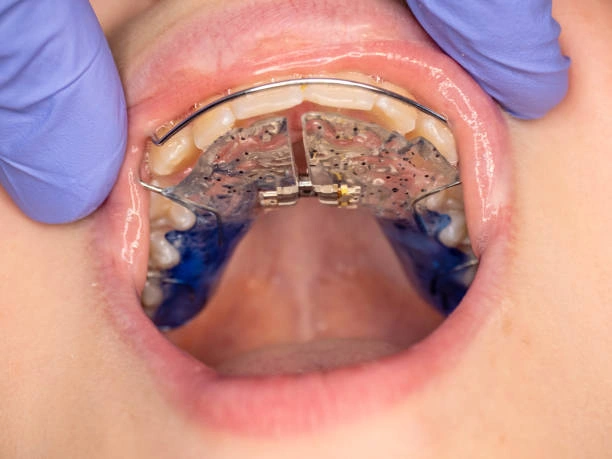
Cost of Treatment and Its Impact on Duration
Orthodontists emphasize the need to set a realistic budget covering:
- The cost of orthodontic appliances.
- The cost of surgery (if necessary).
- Follow-up visits and radiographic imaging.
- Retainers and post-treatment protective devices.
Some modern treatments, such as clear aligners or corrective surgeries, are more expensive but can shorten treatment duration in certain cases. Hence, specialists encourage early consultation and avoiding non-professional or at-home solutions, which often delay progress and increase both treatment time and costs in the future.
Duration of Open Bite Treatment – Conclusion
Regardless of the patient’s age or the cause of the problem, the duration of open bite treatment remains a shared decision between the patient, family, and doctor. Early intervention and proper guidance reduce the treatment time and ensure more stable results.
No sign of an abnormal gap between the front teeth should be ignored — neglecting the issue can lead to years of treatment and significant physical and psychological burdens later.
Consider the duration of open bite treatment an investment in quality of life, appearance, and oral health — achieved through commitment, awareness, and specialized consultation.
Frequently Asked Questions (FAQ)
| Question | Answer |
|---|---|
| What are the causes of open bite? | Habits like thumb or pacifier sucking, breathing problems, unbalanced jaw growth, or genetic factors. |
| How long does open bite treatment take for children? | Usually between 3 months and 1.5 years, depending on the cause, treatment type, and the child’s response. |
| Does open bite require surgery? | Only in complex or skeletal cases in adults; orthodontic treatment alone is usually sufficient for children. |
| Can open bite return after treatment? | Yes, if retainers are not used properly or bad habits continue — regular follow-up is essential. |
| Why are retainers important after orthodontics? | They preserve results and prevent relapse; they are worn for 6 months to 2 years, depending on the dentist’s advice. |
| What is the cost of open bite treatment? | It varies depending on devices and techniques — from a few thousand to tens of thousands based on complexity. |
| Does early treatment affect the duration? | Absolutely — early diagnosis and intervention shorten treatment time and double the chances of lasting success. |
